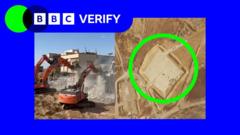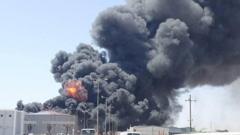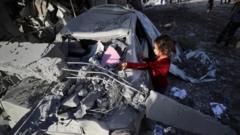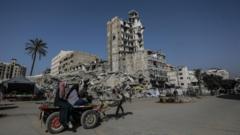Humanitarian agencies express concern over potential restrictions on aid access for vulnerable populations.
**Israel Moves to Establish Aid Distribution Centres in Gaza Amidst Controversy**

**Israel Moves to Establish Aid Distribution Centres in Gaza Amidst Controversy**
Satellite images reveal construction of new sites as US-initiated aid plan faces UN rejection.
Israel is actively creating construction sites in Gaza intended to serve as humanitarian aid distribution centres, as revealed by recent satellite imagery. This move comes in the wake of a proposed aid plan that has been met with substantial opposition from the United Nations and other international leaders. The Israeli government had previously halted food and medicine deliveries into Gaza as a strategy to pressure Hamas regarding hostage situations, a shutdown that has led to alarming shortages of vital supplies, risking the well-being of Gaza’s approximately 2.1 million residents.
The United States has expressed plans to launch a new system for providing humanitarian assistance, establishing these distribution hubs that will be managed by private companies with the aid of security contractors and Israeli forces. Images from BBC Verify indicate that land has been prepared, with new roads and staging areas emerging across numerous locations in southern and central Gaza over the last weeks. While specific locations for the hubs remain undisclosed, sources suggest at least four centres will be located in the southern part of Gaza, with one additional site potentially established in the north.
The Gaza Humanitarian Foundation announced intentions to supply food, water, and hygiene kits to around 1.2 million individuals, which constitutes less than 60% of the population. Criticism has arisen from the UN and various humanitarian organisations, highlighting concerns that the planned aid distribution could reinforce existing inequalities by limiting access to the most vulnerable groups. The UN has declined to cooperate with the proposed plan, denouncing it as a breach of essential humanitarian principles.
BBC Verify identified potential aid distribution sites that are reminiscent of existing open-air facilities within Gaza, with significant development noticeable at one site, which is closely situated to an Israel Defense Forces (IDF) base. Multiple satellite images from early May depict ongoing construction activities, including the establishment of a protected staging area strategically placed near the border with Egypt.
Analysts have asserted that the newly identified sites may serve as secure aid distribution points, aligning with the IDF's objective to maintain control over the operations. The situation remains fluid, awaiting final approval from the Israeli government.
In the broader context, the IDF continues operations within Gaza, adhering to its assertions of compliance with international law, even as humanitarian demands intensify. The UN and humanitarian agencies persist in calling for improved access to aid along established routes rather than through militarised hubs, urging an end to the Israeli blockade that threatens the survival of countless individuals trapped in worsening conditions.
The United States has expressed plans to launch a new system for providing humanitarian assistance, establishing these distribution hubs that will be managed by private companies with the aid of security contractors and Israeli forces. Images from BBC Verify indicate that land has been prepared, with new roads and staging areas emerging across numerous locations in southern and central Gaza over the last weeks. While specific locations for the hubs remain undisclosed, sources suggest at least four centres will be located in the southern part of Gaza, with one additional site potentially established in the north.
The Gaza Humanitarian Foundation announced intentions to supply food, water, and hygiene kits to around 1.2 million individuals, which constitutes less than 60% of the population. Criticism has arisen from the UN and various humanitarian organisations, highlighting concerns that the planned aid distribution could reinforce existing inequalities by limiting access to the most vulnerable groups. The UN has declined to cooperate with the proposed plan, denouncing it as a breach of essential humanitarian principles.
BBC Verify identified potential aid distribution sites that are reminiscent of existing open-air facilities within Gaza, with significant development noticeable at one site, which is closely situated to an Israel Defense Forces (IDF) base. Multiple satellite images from early May depict ongoing construction activities, including the establishment of a protected staging area strategically placed near the border with Egypt.
Analysts have asserted that the newly identified sites may serve as secure aid distribution points, aligning with the IDF's objective to maintain control over the operations. The situation remains fluid, awaiting final approval from the Israeli government.
In the broader context, the IDF continues operations within Gaza, adhering to its assertions of compliance with international law, even as humanitarian demands intensify. The UN and humanitarian agencies persist in calling for improved access to aid along established routes rather than through militarised hubs, urging an end to the Israeli blockade that threatens the survival of countless individuals trapped in worsening conditions.





















